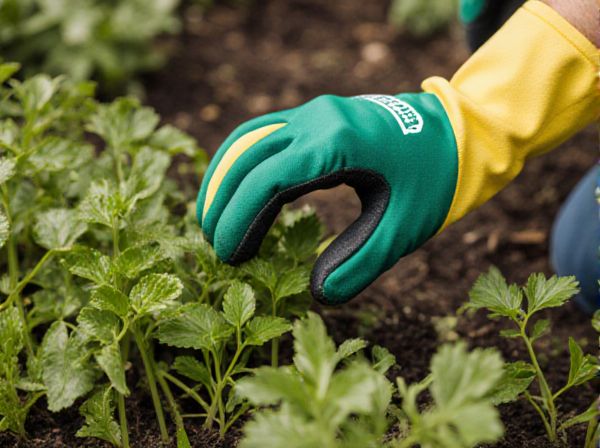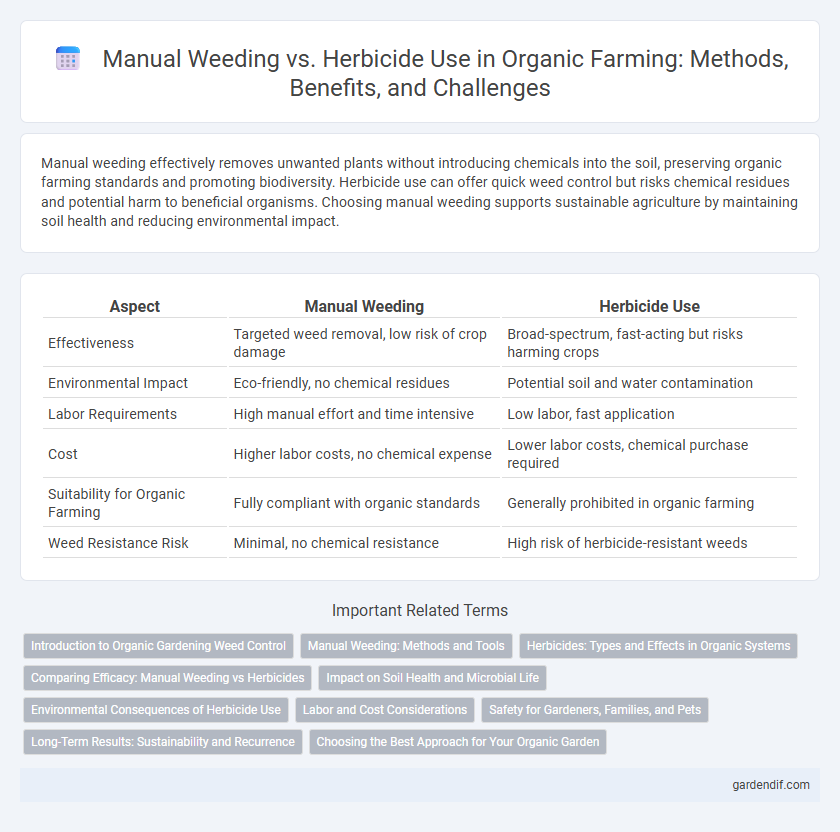
Manual weeding vs herbicide use Illustration
Manual weeding effectively removes unwanted plants without introducing chemicals into the soil, preserving organic farming standards and promoting biodiversity. Herbicide use can offer quick weed control but risks chemical residues and potential harm to beneficial organisms. Choosing manual weeding supports sustainable agriculture by maintaining soil health and reducing environmental impact.
Table of Comparison
| Aspect | Manual Weeding | Herbicide Use |
|---|---|---|
| Effectiveness | Targeted weed removal, low risk of crop damage | Broad-spectrum, fast-acting but risks harming crops |
| Environmental Impact | Eco-friendly, no chemical residues | Potential soil and water contamination |
| Labor Requirements | High manual effort and time intensive | Low labor, fast application |
| Cost | Higher labor costs, no chemical expense | Lower labor costs, chemical purchase required |
| Suitability for Organic Farming | Fully compliant with organic standards | Generally prohibited in organic farming |
| Weed Resistance Risk | Minimal, no chemical resistance | High risk of herbicide-resistant weeds |
Introduction to Organic Gardening Weed Control
Manual weeding is a cornerstone of organic gardening weed control, offering a chemical-free method that preserves soil health and biodiversity. Herbicide use contradicts organic principles, as synthetic chemicals can disrupt microbial activity and harm beneficial insects. Effective organic weed management relies on mechanical removal combined with mulching, crop rotation, and cover cropping to suppress weed growth naturally.
Manual Weeding: Methods and Tools
Manual weeding involves using hand tools such as hoes, hand forks, and weeders to remove unwanted plants from organic gardens without chemicals. Techniques like shallow hoeing and hand-pulling target weeds early, minimizing soil disturbance and preserving beneficial organisms. Efficient manual weeding improves soil aeration and supports the growth of organic crops by reducing competition for nutrients and water.
Herbicides: Types and Effects in Organic Systems
Herbicides used in organic systems primarily include natural options such as vinegar-based solutions, fatty acid formulations, and essential oil extracts, which target weed growth without synthetic chemicals. These organic herbicides effectively reduce weed competition but may require repeated applications and careful timing to minimize crop damage. Their selective use supports soil health and biodiversity, aligning with organic farming principles and reducing long-term environmental impact compared to conventional synthetic herbicides.
Comparing Efficacy: Manual Weeding vs Herbicides
Manual weeding offers targeted removal of weeds, preserving soil structure and beneficial organisms, while herbicides provide rapid, broad-spectrum control but may impact non-target plants and soil health. Studies show manual weeding achieves high efficacy in small-scale or organic systems, with weed removal rates often exceeding 90% when performed regularly. Herbicides deliver consistent weed suppression in large-scale conventional farming but raise concerns about resistance and environmental contamination.
Impact on Soil Health and Microbial Life
Manual weeding preserves soil structure and promotes diverse microbial communities by avoiding chemical disturbances found in herbicide use. Herbicides can disrupt soil microbial balance, reducing beneficial bacteria and fungi essential for nutrient cycling and soil fertility. Maintaining healthy microbial ecosystems through manual weeding enhances organic matter decomposition and supports long-term soil health in sustainable agricultural practices.
Environmental Consequences of Herbicide Use
Herbicide use in agriculture disrupts soil microbial communities, leading to decreased biodiversity and soil fertility over time. Chemical residues from herbicides can contaminate water sources, harming aquatic ecosystems and bioaccumulating in food chains. Manual weeding presents a sustainable alternative by preserving soil health and preventing environmental contamination associated with synthetic herbicides.
Labor and Cost Considerations
Manual weeding in organic farming demands significant labor input, often increasing operational costs due to the time-intensive nature of the process. Herbicide use, while reducing labor requirements, introduces chemical expenses and potential environmental impacts that may affect long-term sustainability. Balancing manual labor costs against herbicide investments is crucial for optimizing financial efficiency in organic weed management.
Safety for Gardeners, Families, and Pets
Manual weeding significantly reduces exposure to toxic chemicals, ensuring greater safety for gardeners, families, and pets compared to herbicide use. Herbicides often contain harmful substances that can persist in soil and pose health risks through skin contact, inhalation, or accidental ingestion. Choosing manual weeding supports a safer, chemical-free garden environment, minimizing potential health hazards for all household members.
Long-Term Results: Sustainability and Recurrence
Manual weeding promotes long-term soil health by avoiding chemical residues, ensuring sustainable crop growth and improving biodiversity. Herbicide use, while effective for immediate weed control, often leads to herbicide-resistant weed populations, increasing recurrence and compromising future sustainability. Sustainable organic farming prioritizes manual weeding to maintain ecological balance and reduce dependency on synthetic chemicals over time.
Choosing the Best Approach for Your Organic Garden
Manual weeding preserves soil health and biodiversity by avoiding chemical residues that herbicides introduce, making it ideal for organic gardens. Herbicide use, although effective for large-scale weed control, often conflicts with organic standards and can harm beneficial organisms. Selecting manual weeding enhances the sustainability and ecological balance of your organic garden, ensuring healthier plant growth and soil vitality.
Manual weeding vs herbicide use Infographic

 gardendif.com
gardendif.com